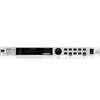Behringer FEEDBACK DESTROYER PRO DSP1124P Manual - Page 10
A Few Quick Steps To Eliminate Feedback, Control Elements - user manual
 |
View all Behringer FEEDBACK DESTROYER PRO DSP1124P manuals
Add to My Manuals
Save this manual to your list of manuals |
Page 10 highlights
FEEDBACK DESTROYER PRO DSP1124P 2.4 Using the FEEDBACK DESTROYER PRO in a studio environment With its highly flexible configuration the DSP1124P also delivers good results in a professional studio or home recording environment, as it provides a maximum of 12 fully parametric equalizers per channel in Parametric EQ mode. Thus, you can realize any application ranging from slight processing to the total manipulation of music signals. For example, you can use the DSP1124P as an equalizer for your studio monitors or to enhance the EQs in your mixing console, as these are often only semi-parametric. 3. A FEW QUICK STEPS TO ELIMINATE FEEDBACK Irrespective of whether you need the DSP1124P to protect the FOH or the monitor mix against feedback, the following procedure is always the same and should be done before the concert, so as to eliminate basic feedback problems right before the show begins: s Check the setting of the OPERATING LEVEL switch on the rear of the unit. For most P.A. systems, this switch should be set to +4 dB. In doubt, please consult the user’s manual of your mixing console. Always make sure that the audio signal levels are set correctly (see control element ). s Switch on the unit, and use the JOG WHEEL (rotary control) to select preset 1. The preset table (see table 11.3) lists the various DSP1124P presets available. s Using the DSP1124P in the monitor path: Turn up the Aux Send or Mon. controls in the first mic channel, until the microphone starts to produce feedback. If more than one monitor paths is being used, this procedure must be done separately for each path. Repeat for each susceptible mic channel. s Using the DSP1124P on channel/sub-group inserts: Deliberately induce feedback by setting the channel/ sub-group faders to 0 dB and raising the gain controls for the individual microphones in turn. In either case, the FEEDBACK DESTROYER PRO will suppress feedback as soon as it is produced—the corresponding LED will stop flashing and stay lit. The various edit options available are described in chapter 7. But don’t let us do the second step before the first: 4. CONTROL ELEMENTS The BEHRINGER FEEDBACK DESTROYER PRO is equipped with ten parameter keys, one JOG WHEEL (rotary control) and a numeric LED DISPLAY. By means of an 8-segment LED meter, each of the two fully independent channels can be monitored. Each of the 24 filters has one LED assigned to it, which informs about the status of the filter. Fig. 4.1: Display section of the FEEDBACK DESTROYER PRO 1 The LED METER is used to monitor the output level. Each channel has eight LEDs assigned to it. When the Clip LED lights up frequently, this warns you of digital distortion. If the DSP1124P is set to Total Bypass mode (see ), the level meter reads the input level. + Please always use appropriate level settings, as this is essential for successful feedback elimination. 2 The DSP1124P features 24 filters, i.e. 12 filters per channel. These filters can be monitored conveniently with the STATUS INDICATOR next to the DISPLAY. 12 LEDs inform you about the status of the filters on each channel (left/right). A constantly lit LED signals the following conditions: 10 4. A FEW QUICK STEPS TO ELIMINATE FEEDBACK















